Synthesis, Characterization, and Electrochemistry of Diferrocenyl β-Diketones, -Diketonates, and Pyrazoles †
Abstract
:1. Introduction
2. Results and Discussion
2.1. Synthesis and Characterization
2.2. Molecular Solid-State Structure
2.3. Electrochemistry
3. Conclusions
4. Materials and Methods
4.1. General Procedures
4.2. Instruments
4.3. Crystallography
4.4. Electrochemistry
4.5. Reagents
4.6. Synthesis of 1-Ferrocenyl-2-[2-(2-methoxyethoxy)ethoxy]ethanone (4)
4.7. Synthesis of 2-Butyl-1,3-diferrocenyl-1,3-propandione (7)
4.8. Synthesis of 2-(2-[2-(2-Methoxyethoxy)ethoxy]ethyl)-1,3-diferrocenyl-1,3-propandione (9)
4.9. Synthesis of tris-(1,3-Diferrocenylpropane-1,3-dionato-κ2-O,O′)titanium(III) (10)
4.10. Synthesis of tris-(1,3-Diferrocenylpropane-1,3-dionato-κ2-O,O′)iron(III) (11)
4.11. Synthesis of bis-(1,3-Diferrocenylpropane-1,3-dionato-κ2-O,O′)difluoro-borane(III) (12)
4.12. Synthesis of 3,5-Diferrocenyl-1H-pyrazole (13)
4.13. Synthesis of 1-Methyl-3,5-diferrocenyl-1H-pyrazole (14)
4.14. Synthesis of 1-Phenyl-3,5-diferrocenyl-1H-pyrazole (15)
Supplementary Materials
Author Contributions
Funding
Conflicts of Interest
References
- Lang, H.; Buschbeck, R. Deposition of metals and metal oxides by means of metal enolates. In Chem. of Metal Enolates; Zabicky, J., Ed.; John Wiley & Sons: Chichester, UK, 2009; Volume 2, pp. 929–1017. [Google Scholar]
- Vigato, P.A.; Peruzzo, V.; Tamburini, S. The evolution of β-diketone or β-diketophenol ligands and related complexes. Coord. Chem. Rev. 2009, 253, 1099–1201. [Google Scholar] [CrossRef]
- Aromí, G.; Gamez, P.; Reedijk, J. Poly beta-diketones: Prime ligands to generate supramolecular metalloclusters. Coord. Chem. Rev. 2008, 252, 964–989. [Google Scholar] [CrossRef]
- Hoshino, Y. Molecular design for long-range electronic communication between metals. Platinum Met. Rev. 2001, 45, 2–11. [Google Scholar]
- Sievers, R.E.; Sadlowski, J.E. Volatile Metal complexes. Science 1978, 201, 217–223. [Google Scholar] [CrossRef]
- Preuß, A.; Korb, M.; Rüffer, T.; Bankwitz, J.; Georgi, C.; Jakob, J.; Schulz, S.E.; Lang, H. A β-ketoiminato palladium(II) complex for palladium deposition. Z. Nat. 2019, 74, 901–912. [Google Scholar] [CrossRef] [Green Version]
- Preuß, A.; Korb, M.; Rüffer, T.; Bankwitz, J.; Georgi, C.; Jakob, J.; Schulz, S.E.; Lang, H. Synthesis of β-ketoiminato copper(II) complexes and their use in copper deposition. Z. Anorg. Allg. Chem. 2020, 646, 670–680. [Google Scholar] [CrossRef]
- Siedle, A.R. Comprehensive Coordination Chemistry; Wilkinson, G., Gillard, R.D., McCleverty, J.A., Eds.; Pergamon Press: New York, NY, USA, 1987; Volume 2, pp. 365–412. [Google Scholar]
- Kemp, K.C.; Fourie, E.; Conradie, J.; Swarts, J.C. Ruthenocene-containing β-diketones: Synthesis, pKa′ values, keto–enol isomerization kinetics, and electrochemical aspects. Organometallics 2008, 27, 353–362. [Google Scholar] [CrossRef]
- Banger, K.K.; Kornilov, A.; Claessen, R.U.; Eisenbraun, E.T.; Kaloyeros, A.E.; Toscano, P.J.; Welch, J.T. The first metal complex containing a silylated β-diketonate ligand: Bis(2,2,6,6-tetramethyl-2-sila-3,5-heptanedionato) copper(II). Inorg. Chem. Commun. 2001, 4, 496–500. [Google Scholar] [CrossRef]
- Luo, B.; Gladfelter, W.L. Chemical Vapour Deposition of Metals: W., Al, Cu and Ru. In Chemical Vapour Deposition: Precursors, Processes and Applications; Jones, A.C., Hitchman, M.L., Eds.; RSC Publishing: Cambridge, UK, 2009; pp. 320–356. [Google Scholar]
- Pousaneh, E.; Korb, M.; Assim, K.; Rüffer, T.; Dzhagan, V.; Noll, J.; Zahn, D.R.T.; Schulz, S.E.; Lang, H. Iron(III) β-diketonates: CVD precursors for iron oxide film formation. Inorg. Chim. Acta 2019, 487, 1–11. [Google Scholar] [CrossRef]
- Schmidt, H.; Jakob, A.; Haase, T.; Kohse-Höinghaus, K.; Schulz, S.E.; Wächtler, T.; Gessner, T.; Lang, H. nBu3P-Silber(I)-β-diketonate: Synthese, Gasphasenuntersuchungen und Verwendung als CVD-Precursoren. Z. Anorg. Allg. Chem. 2005, 631, 2786–2791. [Google Scholar] [CrossRef]
- Assim, K.; Melzer, M.; Korb, M.; Rüffer, T.; Noll, J.; Georgi, C.; Schulz, S.E.; Lang, H. Bis(β-diketonato)- and allyl-(β-diketonato)-palladium(II) complexes: Synthesis, characterization and MOCVD application. RSC Adv. 2016, 6, 102557–102569. [Google Scholar] [CrossRef] [Green Version]
- Aaltonen, T.; Ritala, M.; Leskelä, M. ALD of rhodium thin films from Rh (acac)3 and oxygen. Electrochem. Solid State Lett. 2005, 8, C99–C101. [Google Scholar] [CrossRef]
- Silvennoinen, R.J.; Jylhä, O.J.T.; Lindblad, M.; Sainio, J.P.; Puurunen, R.L.; Krause, A.O.I. Atomic layer deposition of iridium(III) acetylacetonate on alumina, silica–alumina, and silica supports. Appl. Surf. Sci. 2007, 253, 4103–4111. [Google Scholar] [CrossRef]
- Elam, J.W.; Zinovev, A.; Han, C.Y.; Wang, H.H.; Welp, U.; Hryn, J.N.; Pellin, M.J. Atomic layer deposition of palladium films on Al2O3 surfaces. Thin Solid Films 2006, 515, 1664–1673. [Google Scholar] [CrossRef]
- Törndahl, T.; Ottosson, M.; Carlsson, J.-O. Copper oxide films grown by atomic layer deposition from bis(tri-n-butylphosphane)-copper(I)acetylacetonate on Ta, TaN, Ru, and SiO2. J. Electrochem. Soc. 2006, 153, C146–C151. [Google Scholar]
- Päiväsaari, J.; Putkonen, M.; Niinistö, L. A comparative study on lanthanide oxide thin films grown by atomic layer deposition. Thin Solid Film. 2005, 472, 275–281. [Google Scholar] [CrossRef]
- Buono-Core, G.E.; Klahn, A.H.; Castillo, C.; Bustamante, M.J.; Muñoz, E.; Cabello, G.; Chornik, B. Synthesis and evaluation of bis-β -diketonate dioxotungsten(VI) complexes as precursors for the photodeposition of WO3 films. Polyhedron 2011, 30, 201–206. [Google Scholar] [CrossRef]
- Pousaneh, E.; Preuß, A.; Assim, K.; Noll, J.; Jakob, A.; Rüffer, T.; Lang, H. [Y(dbm)3(H2O)]: Synthesis, thermal behavior and spin-coating precursor for Y2O3 layer formation. J. Rare Earth 2017, 35, 1248–1254. [Google Scholar] [CrossRef]
- Marçal, A.L.; de Faria, E.H.; de Faria Borges Machado, J.K.; Nassar, E.J.; Ciuffi, K.J.; Calefi, P.S. Preparation and characterization of silicate nanofilms doped with europium β-diketonate complexes. Thin Solid Films 2012, 520, 6541–6546. [Google Scholar]
- Chen, F.-F.; Bian, Z.-Q.; Lou, B.; Ma, E.; Liu, Z.-W.; Nie, D.-B.; Chen, Z.-Q.; Bian, J.; Chen, Z.-N.; Huang, C.-H. Sensitised near-infrared emission from lanthanides using an iridium complex as a ligand in heteronuclear Ir2Ln arrays. Dalton Trans. 2008, 5577–5583. [Google Scholar] [CrossRef]
- Endo, A.; Tsuboya, H.; Fujita, N.; Ito, Y.; Hashimoto, T.; Hayashita, T. Preparation and electrochemical properties of novel cyclic dinuclear acetylacetonato ruthenium complexes doubly bridged with sulfur and/or disulfur. Inorg. Chim. Acta 2011, 373, 142–149. [Google Scholar] [CrossRef]
- Wang, G.-L.; Lin, Y.-J.; Jin, G.-X. Anion-Templated assembly of half-sandwich rhodium-based multinuclear metallamacrocycles. Chem. Eur. J. 2011, 17, 5578–5587. [Google Scholar] [CrossRef]
- Forniés, J.; Martínez, F.; Navarro, R.; Urriolabeitia, E.P. Reactivity of (NBu4)[Pt(C6F5)2(acac)] toward electrophilic metal centers: metal–metal vs. metal–cγ(acac) bond formation. Crystal structure of [PtAg(C6F5)2(acac)(CH2Cl2)]2, a complex containing a μ2-acac-O,O′ bridging ligand and a coordinated dichloromethane. Organometallics 1996, 15, 1813–1819. [Google Scholar]
- Muthusamy, G.; Jayakumar, N.; Manonmani, B.; Shantha, R.; Natarajan, K. Bis-β-diketonate bridged binuclear complexes of ruthenium(II) and rhodium(I) containing triphenylphosphine. Synth. React. Inorg. Met.-Org. Chem. 1992, 22, 171–183. [Google Scholar] [CrossRef]
- Frosch, W.; Back, S.; Rheinwald, G.; Koehler, K.; Pritzkow, H.; Lang, H. (η2-Alkyne)2CuMe as a synthetic tool in the preparation of numerous inorganic and organic copper(I) species. Organometallics 2000, 19, 4016–4024. [Google Scholar] [CrossRef]
- Lang, H.; Leschke, M.; Melter, M.; Walfort, B.; Koehler, K.; Schulz, S.E.; Gessner, T. Ein- und zweikernige Kupfer(I)- und Silber(I)-Phosphan-Komplexe mit β-Diketonato-Teilstrukturen. Z. Anorg. Allg. Chem. 2003, 629, 2371–2380. [Google Scholar] [CrossRef]
- Cullen, W.R.; Rettig, S.J.; Wickenheiser, E.B. Rhodium(I) complexes of β-diketonates and related ligands as homogeneous hydrogenation catalysts. J. Mol. Catal. 1991, 66, 251–269. [Google Scholar] [CrossRef]
- Cullen, W.R.; Wickenheiser, E.B. Rhodium(I) complexes of β-diketonates and related ligands as hydrosilylation catalysts. J. Organomet. Chem. 1989, 370, 141–154. [Google Scholar] [CrossRef]
- Westcott, S.A. Catalysis using β-diketonato metal complexes. In Chemistry of Metal Enolates; Zabicky, J., Ed.; John Wiley & Sons: Chichester, UK, 2009; pp. 551–579. [Google Scholar]
- Lozano-Gonzales, M.; Ramírez-Apan, M.T.; Nieto-Camacho, A.; Toscano, R.A.; Sanchez-Sandoval, A.L.; Alvarez-Toledano, C. Anticarcinogenic and metal chelation properties of novel hydroxybenzylidene-1-indanone derivatives in the U-251 glioblastoma cell line. New J. Chem. 2018, 42, 3878–3884. [Google Scholar] [CrossRef]
- Swarts, J.C.; Vosloo, T.G.; Cronje, S.J.; du Plessis, W.C.; van Rensburg, C.E.J.; Kreft, E.; van Lier, J.E. Cytotoxicity of a series of ferrocene-containing β-diketones. Anticancer Res. 2008, 28, 2781–2784. [Google Scholar]
- Conradie, J.; Swarts, J.C. Relationship between electrochemical potentials and substitution reaction rates of ferrocene-containing β-diketonato rhodium(I) complexes; cytotoxicity of [Rh(FcCOCHCOPh)(cod)]. Dalton Trans. 2011, 40, 5844–5851. [Google Scholar] [CrossRef] [PubMed]
- du Plessis, W.C.; Vosloo, T.G.; Swarts, J.C. β-Diketones containing a ferrocenyl group: Synthesis, structural aspects, pKa′ values, group electronegativities and complexation with rhodium(I). J. Chem. Soc. Dalton Trans. 1998, 2507–2514. [Google Scholar] [CrossRef]
- Buitendach, B.E.; Gągor, A.; Swarts, J.C. Electrochemical evidence of intramolecular electronic communication in Zr and Hf phthalocyanines bearing ferrocene-containing β-diketonato axial ligands: Structure of [PcHf(FcCOCHCOC6H5)2]. Inorg. Chem. 2013, 52, 10245–10257. [Google Scholar] [CrossRef] [PubMed]
- Buitendach, B.E.; Erasmus, E.; Niemantsverdriet, J.W.; Swarts, J.C. Can electrochemical measurements be used to predict x-ray photoelectron spectroscopic data? The case of ferrocenyl-β-diketonato complexes of manganese(III). Inorg. Chem. 2018, 57, 6606–6616. [Google Scholar] [CrossRef]
- Joubert, C.C.; van As, L.; Jakob, A.; Speck, J.M.; Lang, H.; Swarts, J.C. Intramolecular electronic communication in ferrocene-based β-diketonato copper(II) complexes as observed by an electrochemical study. Polyhedron 2013, 55, 80–86. [Google Scholar] [CrossRef]
- Jakob, A.; Joubert, C.C.; Rüffer, T.; Swarts, J.C.; Lang, H. Chemical and electrochemical oxidation studies on new copper(I) ferrocenyl-functionalised β-diketonates. Inorg. Chim. Acta 2014, 411, 48–55. [Google Scholar] [CrossRef]
- Gericke, H.J.; Muller, A.J.; Swarts, J.C. Electrochemical illumination of intramolecular communication in ferrocene-containing tris-β-diketonato aluminum(III) complexes; cytotoxicity of Al(FcCOCHCOCF3)3. Inorg. Chem. 2012, 51, 1552–1561. [Google Scholar] [CrossRef]
- Makino, K.; Kim, H.S.; Kurasawa, Y. Synthesis of pyrazoles and condensed pyrazoles. J. Heterocycl. Chem. 1999, 36, 321–332. [Google Scholar] [CrossRef]
- Kumari, S.; Paliwal, S.; Chauhan, R. Synthesis of pyrazole derivatives possessing anticancer activity: Current status. Synth. Commun. 2014, 44, 1521–1578. [Google Scholar] [CrossRef]
- Fustero, S.; Simón-Fuentes, A.; Sanz-Cervera, J.F. Recent advances in the synthesis of pyrazoles. Org. Prep. Proced. Int. 2009, 41, 253–290. [Google Scholar] [CrossRef]
- Dadiboyena, S.; Nefzi, A. Synthesis of functionalized tetrasubstituted pyrazolyl heterocycles. Eur. J. Med. Chem. 2011, 46, 5258–5275. [Google Scholar] [CrossRef] [PubMed]
- Chauhan, A.; Sharma, P.K.; Kaushik, N. Pyrazole: A versatile moiety. Int. J. Chem. Tech. Res. 2011, 3, 11–17. [Google Scholar]
- Karrouchi, K.; Radi, S.; Ramli, Y.; Taoufik, J.; Mabkhot, Y.N.; Al-aizari, F.A.; Ansar, M. Synthesis and pharmacological activities of pyrazole derivatives. Molecules 2018, 23, 134. [Google Scholar] [CrossRef] [PubMed] [Green Version]
- Bekhit, A.A.; Ashour, H.M.A.; Ghany, Y.S.A.; Bekhit, A.E.-D.A.; Baraka, A. Synthesis and biological evaluation of some thiazolyl and thiadiazolyl derivatives of 1H-pyrazole as anti-inflammatory antimicrobial agents. Eur. J. Med. Chem. 2008, 43, 456–463. [Google Scholar] [CrossRef]
- Khan, M.F.; Alam, M.M.; Verma, G.; Akhtar, W.; Akhtar, M.; Shaquiquzzaman, M. The therapeutic voyage of pyrazole and its analogs. Eur. J. Med. Chem. 2016, 120, 170–201. [Google Scholar] [CrossRef]
- Ragavan, R.V.; Vijayakumar, V.; Kumari, N.S. Synthesis and antimicrobial activities of novel 1,5-diaryl pyrazoles. Eur. J. Med. Chem. 2010, 45, 1173–1180. [Google Scholar] [CrossRef] [PubMed]
- Bekhit, A.A.; Abdel-Aziem, T. Design, synthesis and biological evaluation of some pyrazole derivatives as anti-inflammatory-antimicrobial agents. Bioorg. Med. Chem. 2004, 12, 1935–1945. [Google Scholar] [CrossRef]
- Bandgar, B.P.; Gawande, S.S.; Bodade, R.G.; Gawande, N.M.; Khobragade, C.N. Synthesis and biological evaluation of a novel series of pyrazole chalcones as anti-inflammatory, antioxidant and antimicrobial agents. Bioorg. Med. Chem. 2009, 17, 8168–8173. [Google Scholar] [CrossRef]
- Riyadh, S.F.; Farghaly, T.A.; Abdallah, M.A.; Abdallah, M.M.; El-Aziz, M.R.A. New pyrazoles incorporating pyrazolylpyrazole moiety: Synthesis, anti-HCV and antitumor activity. Eur. J. Med. Chem. 2010, 45, 1042–1050. [Google Scholar] [CrossRef]
- Park, H.-J.; Lee, K.; Ahn, B.; Lee, J.-C.; Cho, H.; Lee, K.-I. Identification of antitumor activity of pyrazole oxime ethers. Bioorg. Med. Chem. Lett. 2005, 15, 3307–3312. [Google Scholar] [CrossRef]
- Ratković, Z.; Juranić, Z.D.; Stanojković, T.; Manojlović, D.; Vukićević, R.D.; Rudolović, N.; Joksović, M.D. Synthesis, characterization, electrochemical studies and antitumor activity of some new chalcone analogues containing ferrocenyl pyrazole moiety. Bioorg. Chem. 2010, 38, 26–32. [Google Scholar] [CrossRef] [PubMed]
- Damljanović, I.; Vukićević, M.; Rudolović, N.; Palić, R.; Ellmerer, E.; Ratković, Z.; Joksović, M.D.; Vukićević, R.D. Synthesis and antimicrobial activity of some new pyrazole derivatives containing a ferrocene unit. Bioorg. Med. Chem. Lett. 2009, 19, 1093–1096. [Google Scholar]
- Huang, X.-F.; Wang, L.-Z.; Tang, L.; Lu, Y.-X.; Wang, F.; Song, G.-Q.; Ruan, B.-F. Synthesis, characterization and antitumor activity of novel ferrocene derivatives containing pyrazolyl-moiety. J. Organomet. Chem. 2014, 749, 157–162. [Google Scholar] [CrossRef]
- Joksović, M.D.; Marković, V.; Juranić, Z.D.; Stanojković, T.; Jovanović, L.S.; Damljanović, I.S.; Szécsényi, K.M.; Todprović, N.; Trifunović, S.; Vukićević, R.D. Synthesis, characterization and antitumor activity of novel N-substituted α-amino acids containing ferrocenyl pyrazole-moiety. J. Organomet. Chem. 2009, 694, 3935–3942. [Google Scholar] [CrossRef]
- Ren, S.-Z.; Wang, Z.-C.; Zhu, D.; Zhu, X.-H.; Shen, F.-Q.; Wu, S.-Y.; Chen, J.-J.; Xu, C.; Zhu, H.-L. Design, synthesis and biological evaluation of novel ferrocene-pyrazole derivatives containing nitric oxide donors as COX-2 inhibitors for cancer therapy. Eur. J. Med. Chem. 2018, 157, 909–924. [Google Scholar] [CrossRef]
- Klimova, E.I.; López, E.A.V.; Klimova, T.; Toledano, C.A.; Toscano, R.A.; García, M.M. Synthesis of ferrocenylpyrazole derivatives. J. Heterocycl. Chem. 2005, 42, 265–271. [Google Scholar] [CrossRef]
- Shapovalov, S.S.; Tikhonova, O.G.; Kolos, A.V.; Pasynskii, A.A.; Skabitsky, I.V.; Denisov, G.L.; Grinberg, V.A. Synthesis, structure and electrochemical properties of 1-ferrocenyl-3-cymantrenyl-containing β-diketone, pyrazole and mixed-metal chelated complex of p-cymene-ruthenium-iodide. Polyhedron 2018, 149, 73–78. [Google Scholar] [CrossRef]
- Rodionov, A.N.; Gerasimova, M.D.; Osipova, E.Y.; Korlyukov, A.A.; Peregudov, A.S.; Simenel, A.A. Synthesis of bis-ferrocenylpyrazoles via ferrocenylalkylation reaction. Monatsh. Chem. 2017, 148, 925–932. [Google Scholar] [CrossRef]
- Burckhardt, U.; Baumann, M.; Trabesinger, G.; Gramlich, V.; Togni, A. A bimetallic palladium catalyst for asymmetric allylic substitution reactions. Organometllics 1997, 16, 5252–5259. [Google Scholar] [CrossRef]
- Zora, M.; Pinar, M.; Odabaşoglu, A.N.; Büyükgüngör, O.; Turgut, G. Synthesis of ferrocenyl pyrazoles by the reaction of 3-ferrocenylpropynal with hydrazinium salts. J. Organomet. Chem. 2008, 693, 145–154. [Google Scholar] [CrossRef]
- Niedenzu, K.; Serwatowski, J.; Trofimenko, S. Boron derivatives of 3-ferrocenylpyrazole. Inorg. Chem. 1991, 30, 524–527. [Google Scholar] [CrossRef]
- Wolf, L.; Hennig, H. Ferrocensubstituierte 1,3-Diketone. Zeitschrift für Chemie 1963, 3, 469–470. [Google Scholar] [CrossRef]
- Hildebrandt, A.; Pfaff, U.; Lang, H. 5-Membered heterocycles with directly-bonded sandwich and half-sandwich termini as multi-redox systems: Synthesis, reactivity, electrochemistry, structure and bonding. Rev. Inorg. Chem. 2011, 31, 111–141. [Google Scholar] [CrossRef]
- Hildebrandt, A.; Miesel, D.; Lang, H. Electrostatic interactions within mixed-valent compounds. Coord. Chem. Rev. 2018, 371, 56–66. [Google Scholar] [CrossRef]
- Miesel, D.; Hildebrandt, A.; Lang, H. Molecular electrochemistry of multi-redox functionalized 5-membered heterocycles. Curr. Opin. Electrochem. 2018, 8, 39–44. [Google Scholar] [CrossRef]
- Preuß, A.; Korb, M.; Miesel, D.; Rüffer, T.; Hildebrandt, A.; Lang, H. Ferrocenyl naphthalenes: Substituent- and substitution pattern-depending charge transfer studies. Dalton Trans. 2019, 48, 14418–14432. [Google Scholar] [CrossRef]
- Preuß, A.; Notz, S.; Kovalski, E.; Korb, M.; Blaudeck, T.; Hu, X.; Schuster, J.; Miesel, D.; Rüffer, T.; Hildebrandt, A.; et al. Ferrocenyl-pyrenes, ferrocenyl-9,10-phenanthrenediones, and ferrocenyl-9,10-dimethoxyphenanthrenes: Charge-transfer studies and SWCNT functionalization. Chem. Eur. J. 2020, 26, 2635–2652. [Google Scholar] [CrossRef] [Green Version]
- Filipczyk, G.; Lehrich, S.W.; Hildebrandt, A.; Rüffer, T.; Schaarschmidt, D.; Korb, M.; Lang, H. Multiferrocenyl cobalt-based sandwich compounds. Eur. J. Inorg. Chem. 2017, 2017, 263–275. [Google Scholar] [CrossRef]
- Lehrich, S.W.; Hildebrandt, A.; Korb, M.; Lang, H. Electronic modification of redox active ferrocenyl termini and their influence on the electrontransfer properties of 2,5-diferrocenyl-N-phenyl-1H-pyrroles. J. Organomet. Chem. 2015, 792, 37–45. [Google Scholar] [CrossRef]
- Pfaff, U.; Hildebrandt, A.; Schaarschmidt, D.; Rüffer, T.; Low, P.J.; Lang, H. Molecular wires using (oligo)pyrroles as connecting units: An electron transfer study. Organometallics 2013, 32, 6106–6117. [Google Scholar] [CrossRef] [Green Version]
- Al-Shewiki, R.K.; Korb, M.; Hildebrandt, A.; Zahn, S.; Naumov, S.; Buschbeck, R.; Rüffer, T.; Lang, H. Diaqua-β-octaferrocenyltetraphenylporphyrin: A multiredox-active and air-sTable 16π non-aromatic species. Dalton Trans. 2019, 48, 1578–1585. [Google Scholar] [CrossRef] [PubMed]
- Frenzel, P.; Korb, M.; Hildebrandt, A.; Lang, H. Synthesis and electrochemical behavior of ferrocenylfunctionalized metallocenes M(η5−C5H5)2(EFc)2 (M = Ti, Zr; E = O, S, Se). Eur. J. Inorg. Chem. 2018, 2018, 3158–3163. [Google Scholar]
- Pfaff, U.; Hildebrandt, A.; Korb, M.; Schaarschmidt, D.; Rosenkranz, M.; Popov, A.; Lang, H. Five-membered heterocycles as linking units in strongly coupled homobimetallic group 8 metal half-sandwich complexes. Organometallics 2015, 34, 2826–2840. [Google Scholar] [CrossRef]
- Speck, J.M.; Korb, M.; Rüffer, T.; Hildebrandt, A.; Lang, H. Substituent influence on charge transfer interactions in α,α′-diferrocenylthiophenes. Organometallics 2014, 33, 4813–4823. [Google Scholar] [CrossRef]
- Rohde, V.H.G.; Pommerening, P.; Klare, H.F.T.; Oestreich, M. Intramolecularly sulfur-stabilized silicon cations as lewis acid catalysts. Organometallics 2014, 33, 3618–3628. [Google Scholar] [CrossRef]
- Darin, V.A.; Federman Neto, A.; Miller, J.; de Freitas Afonso, M.M.; Fonsatti, H.C.; Lanchote Borges, Á.D. Boron trifluoride etherate as a catalyst in acylation of ferrocene. J. Für Prakt. Chemie 1999, 341, 588–591. [Google Scholar] [CrossRef]
- Vukićević, M.D.; Ratković, Z.R.; Teodorović, A.V.; Stojanović, G.S.; Vukićević, R.D. Acylation of ferrocene: A new approach. Tetrahedron 2002, 58, 9001–9006. [Google Scholar] [CrossRef]
- Lui, H.; Edgar, K.J. Synthesis and characterization of neutral and anionic cellulosic amphiphiles. Carbohydr. Polym. 2014, 113, 480–489. [Google Scholar]
- Gao, Y.; de Jubera, A.M.S.; Mariñas, B.J.; Moore, J.S. Nanofiltration membranes with modified active layer using aromatic polyamide dendrimers. Adv. Funct. Mater. 2013, 23, 598–607. [Google Scholar] [CrossRef]
- Plessis, W.C.; Davis, W.L.; Cronje, S.J.; Swarts, J.C. Structural, thermodynamic and kinetic consequences of a spectroscopic study of the equilibrium between isomeric forms of ferrocene-containing β-diketones. Inorg. Chim. Acta 2001, 314, 97–104. [Google Scholar] [CrossRef]
- Finkelstein, H. Darstellung organischer Jodide aus den entsprechenden Bromiden und Chloriden. Berichte der Deutschen Chemischen Gesellschaft 1910, 43, 1528–1532. [Google Scholar] [CrossRef] [Green Version]
- Baughman, T.W.; Sworen, J.C.; Wagener, K.B. The facile preparation of alkenyl metathesis synthons. Tetrahedron 2004, 60, 10943–10948. [Google Scholar] [CrossRef]
- Appel, R. Tertiary Phosphane/Tetrachloromethane, a Versatile Reagent for Chlorination, Dehydration, and P-N Linkage. Angew. Chem. Int. Ed. 1975, 14, 801–811. [Google Scholar] [CrossRef]
- Samanta, D.; Sawoo, S.; Patra, S.; Ray, M.; Salmain, M.; Sarkar, A. Synthesis of hydrophilic Fischer carbene complexes as organometallic marker and PEGylating agent for proteins. J. Organomet. Chem. 2005, 690, 5581–5590. [Google Scholar] [CrossRef]
- Schaarschmidt, D.; Lang, H. Selective Syntheses of planar-chiral ferrocenes. Organometallics 2013, 32, 5668–5704. [Google Scholar] [CrossRef]
- Korb, M.; Lang, H. A reactivity study of phenyl and ferrocenyl phosphates within the anionic phospho-fries rearrangement. Inorg. Chem. Commun. 2016, 72, 30–32. [Google Scholar] [CrossRef]
- Korb, M.; Schaarschmidt, D.; Lang, H. Anionic phospho-fries rearrangement at ferrocene: One-pot approach to P,O-substituted ferrocenes. Organometallics 2014, 33, 2099–2108. [Google Scholar] [CrossRef]
- Korb, M.; Swarts, P.J.; Miesel, D.; Hildebrandt, A.; Swarts, J.C.; Lang, H. Nucleophilic aromatic substitution reactions for the synthesis of ferrocenyl aryl ethers. Organometallics 2016, 35, 1287–1300. [Google Scholar] [CrossRef]
- Korb, M.; Lang, H. Planar chirality from the chiral pool: Diastereoselective anionic phospho-fries rearrangements at ferrocene. Organometallics 2014, 33, 6643–6659. [Google Scholar] [CrossRef]
- Korb, M.; Lang, H. Multi-ferrocenyl aryl ethers applying nucleophilic aromatic substitution reactions to aryl fluorides. Eur. J. Inorg. Chem. 2017, 276–287. [Google Scholar] [CrossRef] [Green Version]
- Gäbler, C.; Speck, J.M.; Korb, M.; Schaarschmidt, D.; Lang, H. (Ferrocenylthienyl)phosphines: Synthesis, electrochemistry and their use in Suzuki-Miyaura C,C coupling. J. Organomet. Chem. 2016, 813, 26–35. [Google Scholar] [CrossRef]
- Honeycutt, S.C. Kinetics of the cleavage of tetrahydrofuran by n-butyllithium in hydrocarbon solvent. J. Organomet. Chem. 1971, 29, 1–5. [Google Scholar] [CrossRef]
- Stanetty, P.; Koller, H.; Mihovilovic, M. Directed ortho lithiation of phenylcarbamic acid 1, 1-dimethylethyl ester (N-BOC-aniline). Revision and improvements. J. Org. Chem. 1992, 57, 6833–6837. [Google Scholar] [CrossRef]
- Elschenbroich, C. Organometallics, Third, Completely Revised and Extended Edition; Wiley-VCH: Weinheim, Germany, 2006. [Google Scholar]
- Kang, S.K.; Lee, S.; Seo, K.-C.; Yun, S.S. Synthesis and Crystal Structure of Tris(1,3-diphenyl-1,3-propanedionato)Titanium(III). Bull. Korean. Chem. Soc. 2004, 25, 921–923. [Google Scholar]
- Hopmann, K.H.; Kuhn, A.; Conradie, J. Substitution reactions of dichlorobis(betadiketonato-O,O′)titanium(IV) complexes with aryl diolato ligands: An experimental and computational study. Polyhedron 2014, 67, 231–241. [Google Scholar] [CrossRef]
- Kuhn, A.; Tsotetsi, T.A.; Muller, A.; Conradie, J. Isomer distribution and structure of (2,2′-biphenyldiolato)bis(β-diketonato)titanium(IV) complexes: A single crystal X-ray, solution NMR and computational study. Inorg. Chim. Acta 2009, 362, 3088–3096. [Google Scholar] [CrossRef]
- Nakamoto, K. Infrared and Raman Spectra of Inorganic and Coordination Compounds; John Wiley & Sons: New York, NY, USA, 1986. [Google Scholar]
- Joshi, K.C.; Pathak, V.N. Metal chelates of fluorinated 1,3-diketones and related compounds. Coord. Chem. Rev. 1977, 22, 37–122. [Google Scholar] [CrossRef]
- Flack, H.D. On enantiomorph-polarity estimation. Acta Crystallogr. 1983, A39, 876–881. [Google Scholar] [CrossRef]
- Spek, A.L. PLATON SQUEEZE: A tool for the calculation of the disordered solvent contribution to the calculated structure factors. Acta Cryst. 2015, C71, 9–18. [Google Scholar]
- Woisetschläger, O.E.; Geisbauer, A.; Polborn, K.; Sünkel, K.; Beck, W. Spacer-verbrückte Bis-, Tris- und Tetrakis(ferrocenyl)-1,3-Diketone. Z. Anorg. All. Chem. 1999, 625, 2164–2168. [Google Scholar] [CrossRef]
- Patra, M.; Gasser, G.; Wenzel, M.; Merz, K.; Bandow, J.E.; Metzler-Nolte, N. Synthesis and biological evaluation of ferrocene-containing bioorganometallics inspired by the antibiotic platensimycin lead structure. Organometallics 2010, 29, 4312–4319. [Google Scholar] [CrossRef]
- Woisetschläger, O.E.; Geisbauer, A.; Polborn, K.; Beck, W. Kohlenwasserstoffverbrückte Metallkomplexe, XLVIII. Addition von Bis(ferrocenyl)-1,3-diketonen und von Metalldiketonaten an koordinierte, ungesättigte Kohlenwasserstoffe von kationischen Komplexen. J. Organomet. Chem. 2000, 599, 238–246. [Google Scholar] [CrossRef]
- Hobza, P.; Selzle, H.L.; Schlag, E.W. Potential energy surface of the benzene dimer: Ab initio theoretical study. J. Am. Chem. Soc. 1994, 116, 3500–3506. [Google Scholar] [CrossRef]
- Sinnokrot, M.O.; Valeev, E.F.; Sherrill, C.D. Estimates of the ab initio limit for π−π interactions: the benzene dimer. J. Am. Chem. Soc. 2002, 124, 10887–10893. [Google Scholar] [CrossRef]
- Pfaff, U.; Hildebrandt, A.; Korb, M.; Lang, H. The influence of an ethynyl spacer on the electronic properties in 2,5-ferrocenyl-substituted heterocycles. Polyhedron 2015, 86, 2–9. [Google Scholar] [CrossRef]
- Korb, M.; Lehrich, S.W.; Lang, H. Reactivity of ferrocenyl Phosphates bearing (hetero-)aromatics and [3]ferrocenophanes toward anionic phospho-fries rearrangements. J. Org. Chem. 2017, 82, 3102–3124. [Google Scholar] [CrossRef] [PubMed]
- Gäbler, C.; Korb, M.; Schaarschmidt, D.; Speck, J.M.; Hildebrandt, A.; Lang, H. (Ferrocenylthienyl)phosphines for the Suzuki−Miyaura C,C coupling. Inorg. Chem. Commun. 2015, 54, 96–99. [Google Scholar] [CrossRef]
- Lehrich, S.W.; Hildebrandt, A.; Korb, M.; Lang, H. From diferrocenyl-cyclopropenone to diferrocenyl-cyclopropenylium cations and triferrocenylpropenones: An electrochemical study. J. Organomet. Chem. 2017, 847, 105–113. [Google Scholar] [CrossRef]
- Matilainen, K.; Mutikainen, I.; Leskela, M. Group 4 metal alkoxo complexes as catalysts for olefin polymerization: Synthesis and crystal structure of bis (dibenzoylmethanate) dichlorotitanium (IV). Acta Chem. Scand. 1996, 50, 755–758. [Google Scholar] [CrossRef] [Green Version]
- Dubler, E.; Buschmann, R.; Schmalle, H.W. Isomer abundance of bis(β-diketonato) complexes of titanium(IV). Crystal structures of the antitumor compound budotitane [TiIV(bzac)2(OEt)2] and of its dichloro-derivative [TiIV(bzac)2Cl2] (bzac = 1-phenylbutane-1,3-dionate). J. Inorg. Biochem. 2003, 95, 97–104. [Google Scholar] [CrossRef]
- Lord, M.R.; Mannion, J.J.; Hebden, A.J.; Nako, A.E.; Crossley, B.D.; McMullen, M.W.; Janeway, F.D.; Philipf, R.M.; McGowan, P.C. Mechanistic and cytotoxicity studies of group IV β-diketonate complexes. ChemMedChem 2014, 9, 1136–1139. [Google Scholar] [CrossRef] [PubMed]
- Ferguson, G.; Glidewell, C. Enantiomeric disorder in racemic cis- dichlorobis(pentane-2,4-dionato) titanium(IV). Acta Crystallogr. 2001, C57, 264–265. [Google Scholar]
- Glidewell, C.; Turner, G.M.; Ferguson, G. Racemic cis-dichlorobis(2,2,6,6-tetramethyl-3,5-heptanedionato)titanium(IV). Acta Crytallogr. 1996, C52, 11–14. [Google Scholar] [CrossRef]
- Miesel, D.; Hildebrandt, A.; Korb, M.; Low, P.J.; Lang, H. Synthesis and (spectro)electrochemical behavior of 2,5-diferrocenyl-1-phenyl-1H-phosphole. Organometallics 2013, 32, 2993–3002. [Google Scholar] [CrossRef] [Green Version]
- Miesel, D.; Hildebrandt, A.; Korb, M.; Wild, D.A.; Low, P.J.; Lang, H. Influence of P-bonded bulky substituents on electronic interactions in ferrocenyl-substituted phospholes. Chem. Eur. J. 2015, 21, 11545–11559. [Google Scholar] [CrossRef] [PubMed]
- Miesel, D.; Hildebrandt, A.; Korb, M.; Lang, H. Electronic interactions in gold(I) complexes of 2,5-diferrocenyl-1-phenyl-1H-phosphole. J. Organomet. Chem. 2016, 803, 104–110. [Google Scholar] [CrossRef]
- Geiger, W.E.; Barrière, F. Organometallic electrochemistry based on electrolytes containing weakly-coordinating fluoroarylborate anions. Acc. Chem. Res. 2010, 43, 1030–1039. [Google Scholar] [CrossRef]
- Chong, D.; Slote, J.; Geiger, W.E. The role of solvent in the stepwise electrochemical oxidation of nickelocene to the nickelocenium dication. J. Electroanal.Chem. 2009, 630, 28–34. [Google Scholar] [CrossRef]
- Gritzner, G.; Kuta, J. Recommendations on reporting electrode potentials in nonaqueous solvents. Pure Appl. Chem. 1984, 56, 461–466. [Google Scholar] [CrossRef]
- Hildebrandt, A.; Miesel, D.; Yuan, Q.; Freytag, J.; Mahrholdt, J.; Lang, H. Anion and solvent dependency of the electronic coupling strength in mixed valent class II systems. Dalton Trans. 2019, 48, 13162–13168. [Google Scholar] [CrossRef]
- du Plessis, W.C.; Erasmus, J.J.C.; Lamprecht, G.J.; Conradie, J.; Cameron, T.S.; Aquino, M.A.S.; Swarts, J.C. Cyclic voltammetry of ferrocene-containing β-diketones as a tool to obtain group electronegativities. The structure of 3-ferrocenoyl-1,1,1-trifluoro-2-hydroxyprop-2-ene. Can. J. Chem. 1999, 77, 378–386. [Google Scholar] [CrossRef]
- Gericke, H.J.; Barnard, N.I.; Erasmus, E.; Swarts, J.C.; Cook, M.J.; Aquino, M.S.A. Solvent and electrolyte effects in enhancing the identification of intramolecular electronic communication in a multi redox-active diruthenium tetraferrocenoate complex, a triple-sandwiched dicadmium phthalocyanine and a ruthenocene-containing β-diketone. Inorg. Chim. Acta 2010, 363, 2222–2232. [Google Scholar] [CrossRef]
- LeSuer, R.J.; Buttolph, C.; Geiger, W.E. Comparison of the conductivity properties of the tetrabutylammonium salt of tetrakis(pentafluorophenyl)borate anion with those of traditional supporting electrolyte anions in nonaqueous solvents. Anal. Chem. 2004, 76, 6395–6401. [Google Scholar] [CrossRef] [PubMed]
- Barriere, F. Electrostatic modeling of the tunable potential difference between the two consecutive oxidation steps of dinickel bisfulvalene. Organometallics 2014, 33, 5046–5048. [Google Scholar] [CrossRef]
- Grillo, V.A.; Seddon, E.J.; Grant, C.M.; Aromí, G.; Bollinger, J.C.; Folting, K.; Christou, G. Bis(β-diketonate) ligands for synthesis of bismetallic complexes of TiIII, VIII, MnIII and FeIII with a triple-helix structure. Chem. Commun. 1997, 1561–1562. [Google Scholar]
- Krejcik, M.; Danek, M.; Hartl, F. Simple construction of an infrared optically transparent thin-layer electrochemical cell: Applications to the redox reactions of ferrocene, Mn2(CO)10 and Mn(CO)3(3,5-di-t-butyl-catecholate)−. J. Electroanal. Chem. 1991, 317, 179–187. [Google Scholar] [CrossRef]
- Robin, M.B.; Day, P. Mixed valence chemistry-a survey and classification. Adv. Inorg. Chem. Radiochem. 1967, 10, 247–422. [Google Scholar]
- Sheldrick, G.M. A short history of SHELX. Acta Crystallogr. 2008, A64, 112–122. [Google Scholar] [CrossRef] [Green Version]
- Sheldrick, G.M. Crystal structure refinement with SHELXL. Acta Crystallogr. C Struct. Chem. 2015, 71, 3–8. [Google Scholar]
- Farrugia, L.J. WinGX and ORTEP for windows: An update. J. Appl. Crystallogr. 2012, 45, 849–854. [Google Scholar] [CrossRef]
- Spek, A.L. Single-crystal structure validation with the program PLATON. J. Appl. Cryst. 2003, 36, 7–13. [Google Scholar] [CrossRef] [Green Version]
- Spek, A.L. Structure validation in chemical crystallography. Acta Cryst. 2009, D65, 148–155. [Google Scholar] [CrossRef] [PubMed]
- Barrière, F.; Geiger, W.E. Use of weakly coordinating anions to develop an integrated approach to the tuning of ΔE1/2 values by medium effects. J. Aa. Chem. Soc. 2006, 128, 3980–3989. [Google Scholar] [CrossRef] [PubMed]
- Barrière, F.; Camire, N.; Geiger, W.E.; Mueller-Westerhoff, U.T.; Sanders, R. Use of medium effects to tune the ΔE1/2 values of bimetallic and oligometallic compounds. J. Am. Chem. Soc. 2002, 124, 7262–7263. [Google Scholar] [CrossRef]
- Nafady, A.; Geiger, W.E. Characterization of the successive one-electron oxidation products of the dicobalt fulvalenediyl (Fv) compound Co2Fv(CO)4 and its phosphine-substituted product. Organometallics 2008, 27, 5624–5631. [Google Scholar] [CrossRef]
- Noviandrs, I.; Brown, K.N.; Fleming, D.S.; Gulyas, P.T.; Lay, P.A.; Masters, A.F.; Phillips, L. The decamethylferrocenium/decamethylferrocene redox couple: A superior redox standard to the ferrocenium/ferrocene redox couple for studying solvent effects on the thermodynamics of electron transfer. J. Phys. Chem. 1999, B103, 6713–6722. [Google Scholar] [CrossRef]
- Ruiz, J.A.; Daniel, M.-C.; Astruc, D. Metallocenes as references for the determination of redox potentials by cyclic voltammetry-Permethylated iron and cobalt sandwich complexes, inhibition by polyamine dendrimers, and the role of hydroxy-containing ferrocenes. Can. J. Chem. 2006, 84, 288–299. [Google Scholar]
- Ruiz, J.A.; Astruc, D. Permethylated electron-reservoir sandwich complexes as references for the determination of redox potentials. Suggestion of a new redox scaleLes complexes sandwichs perméthylés réservoirs délectrons en tant que références pour la détermination des potentiels redox. Suggestion dune nouvelle échelle redox. Comptes Rendus de l’Académie des Sci.-Ser. IIC-Chem. 1998, 1, 21–27. [Google Scholar]
Sample Availability: Samples of the compounds are not available from the authors. |

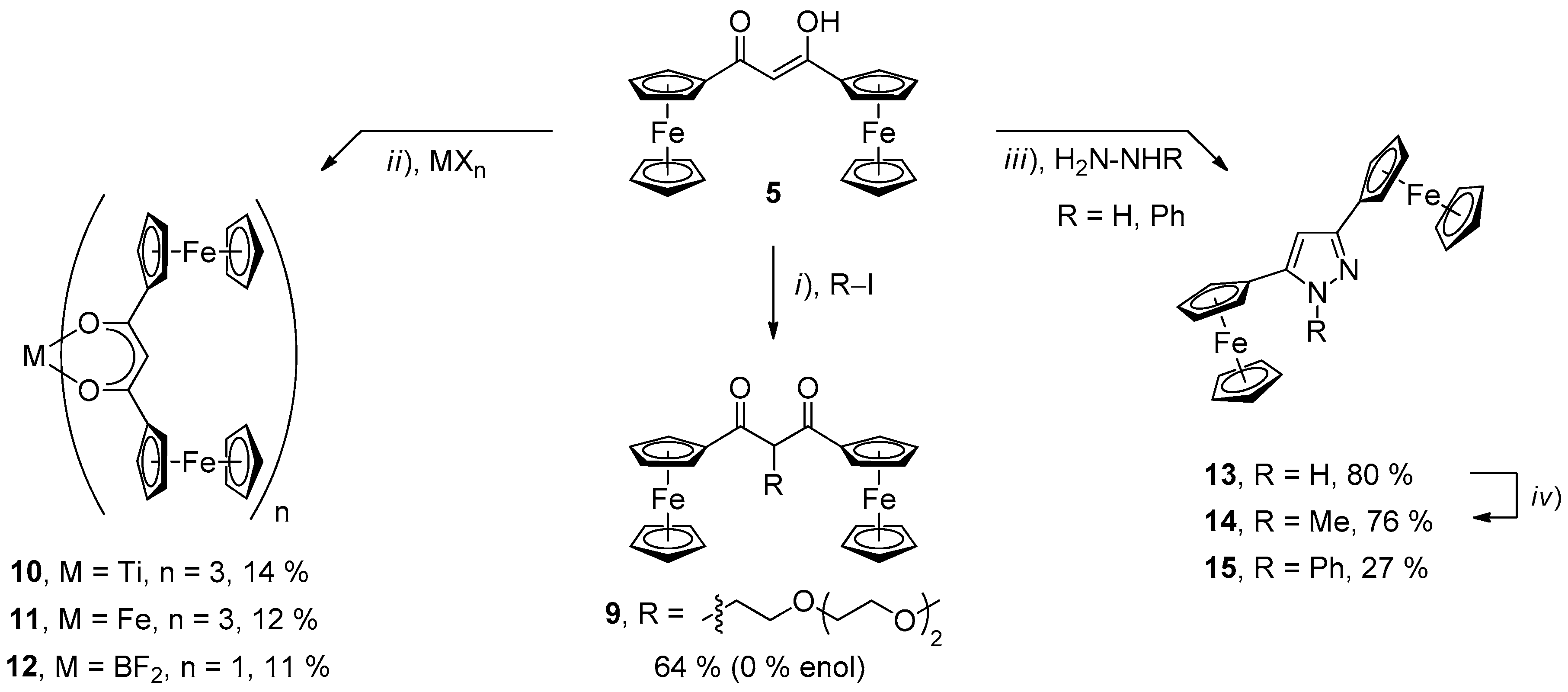
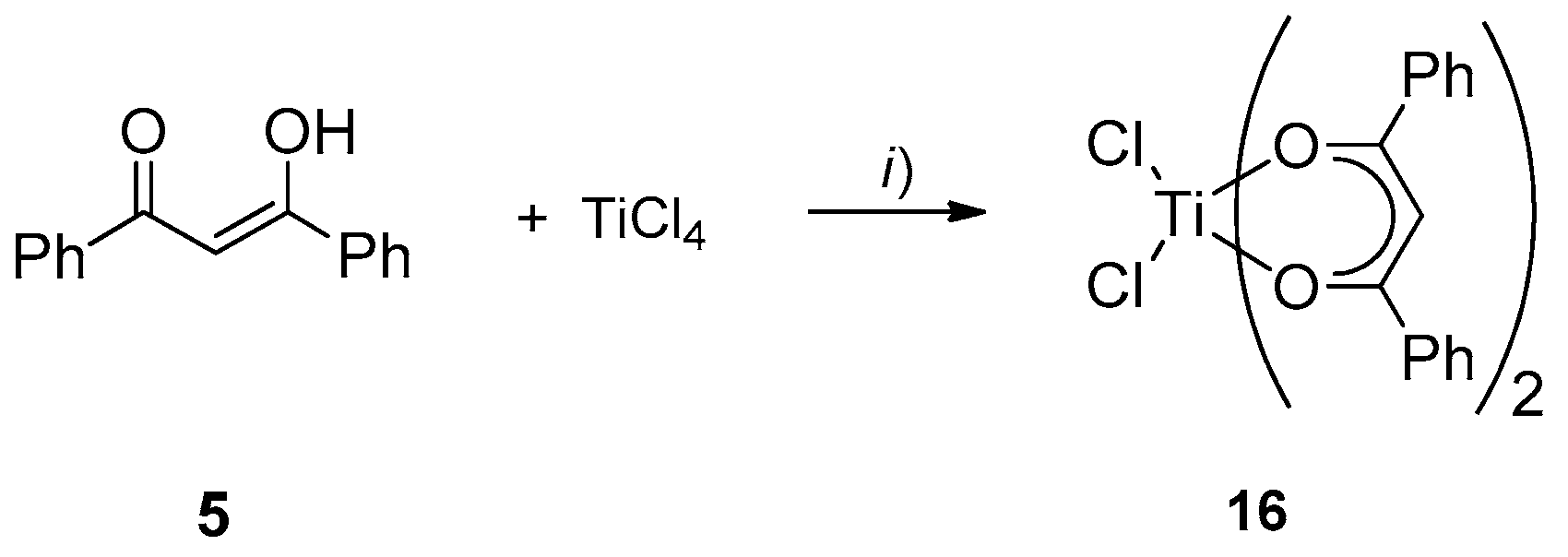

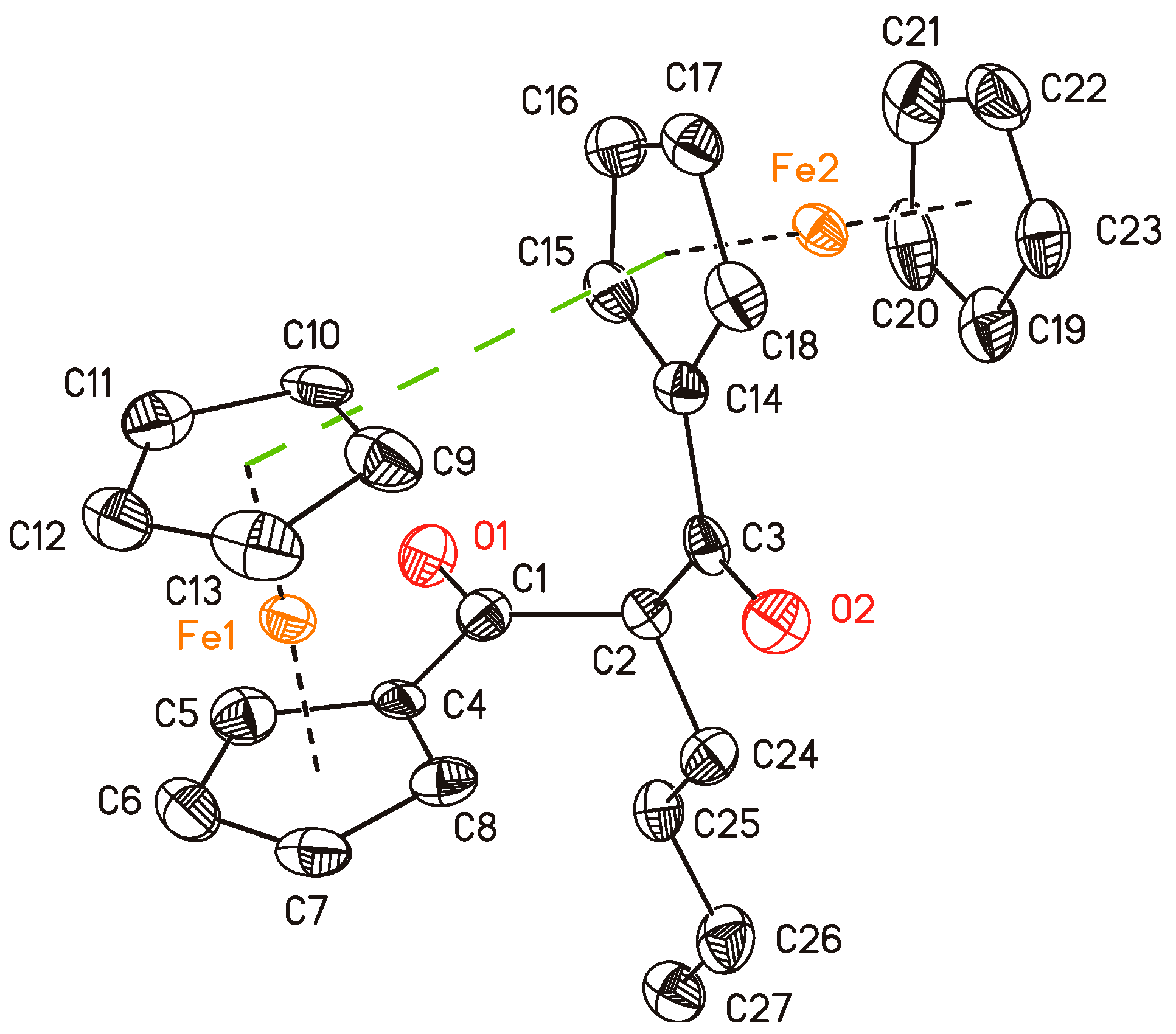

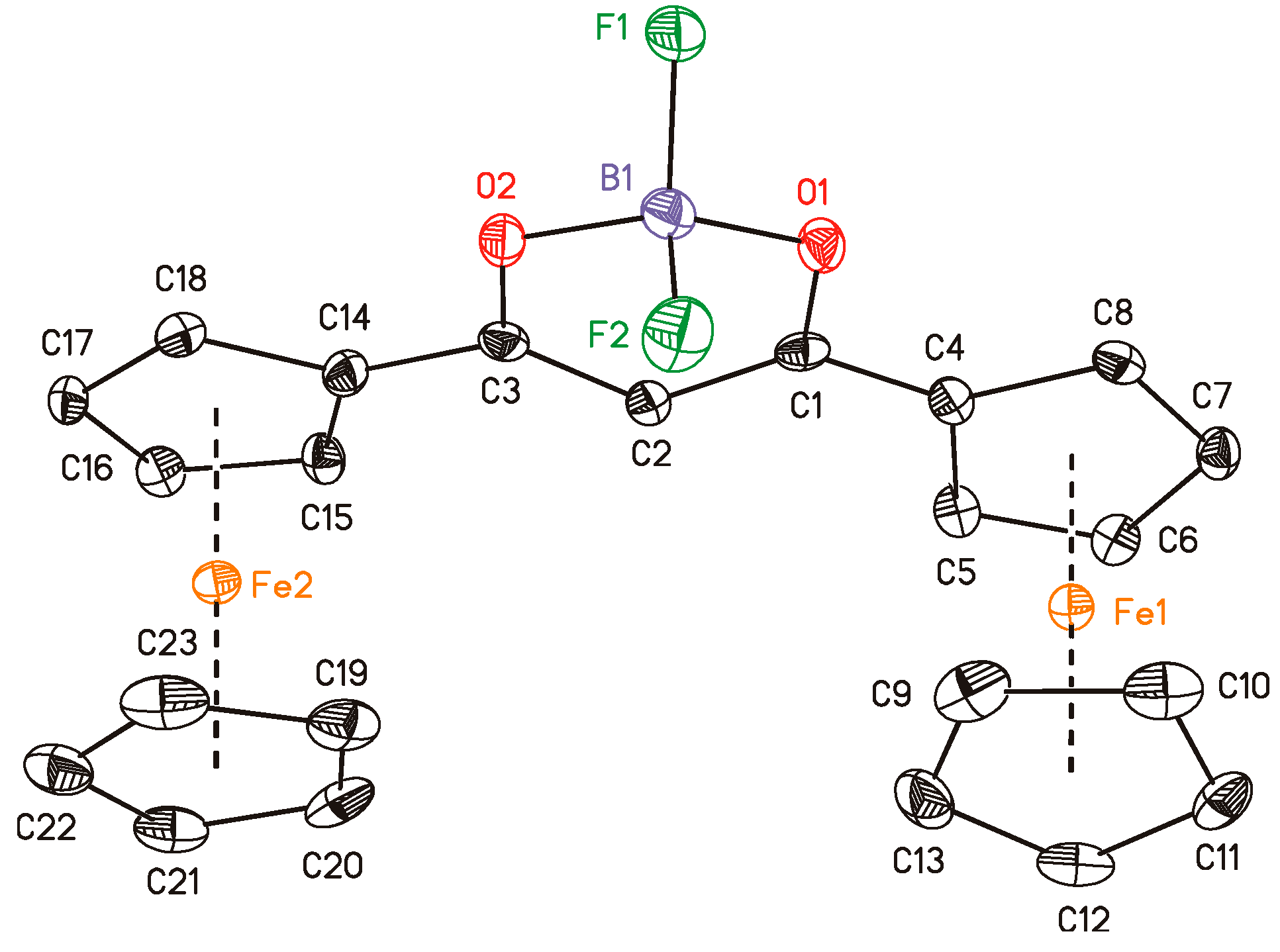
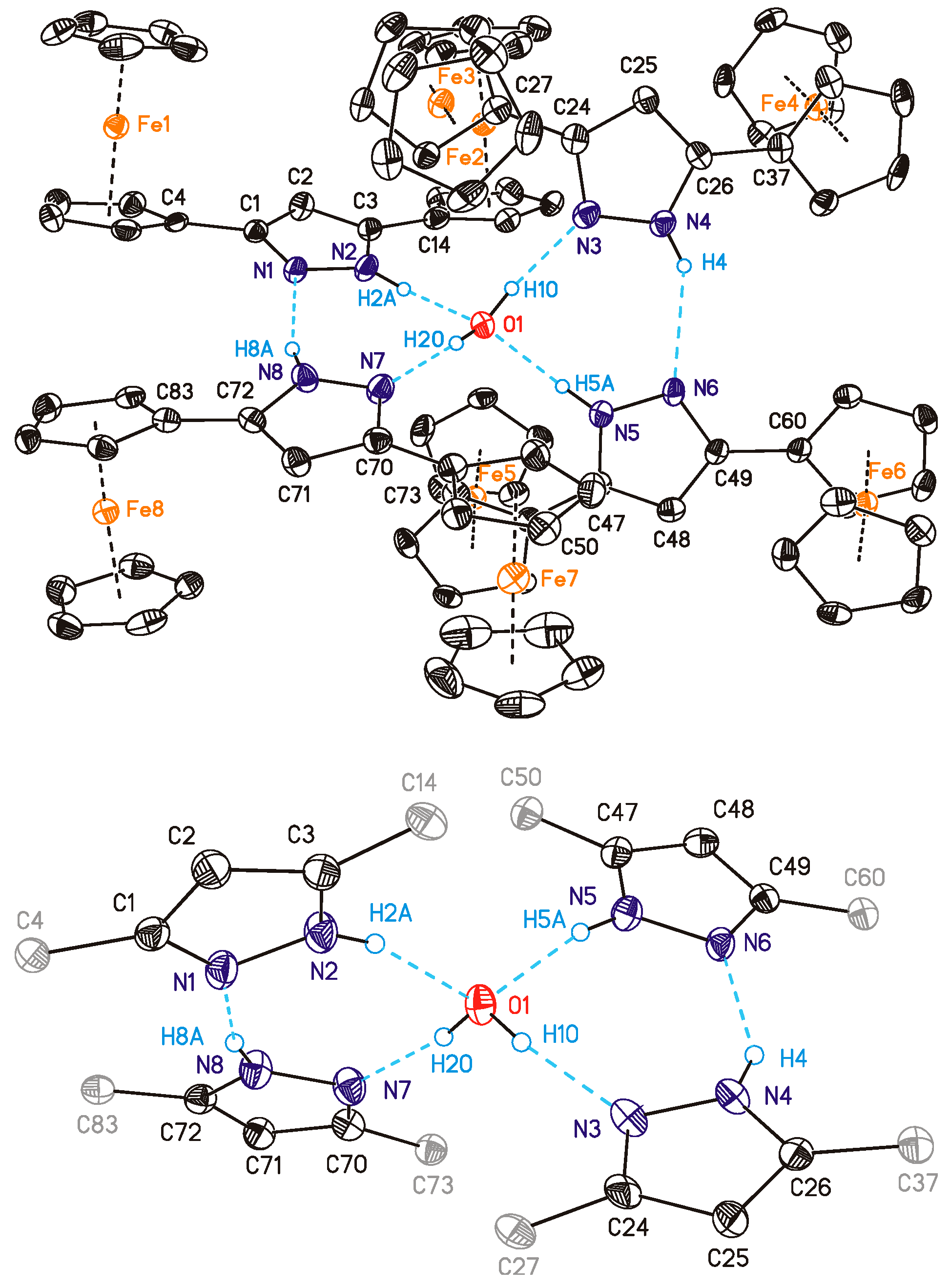
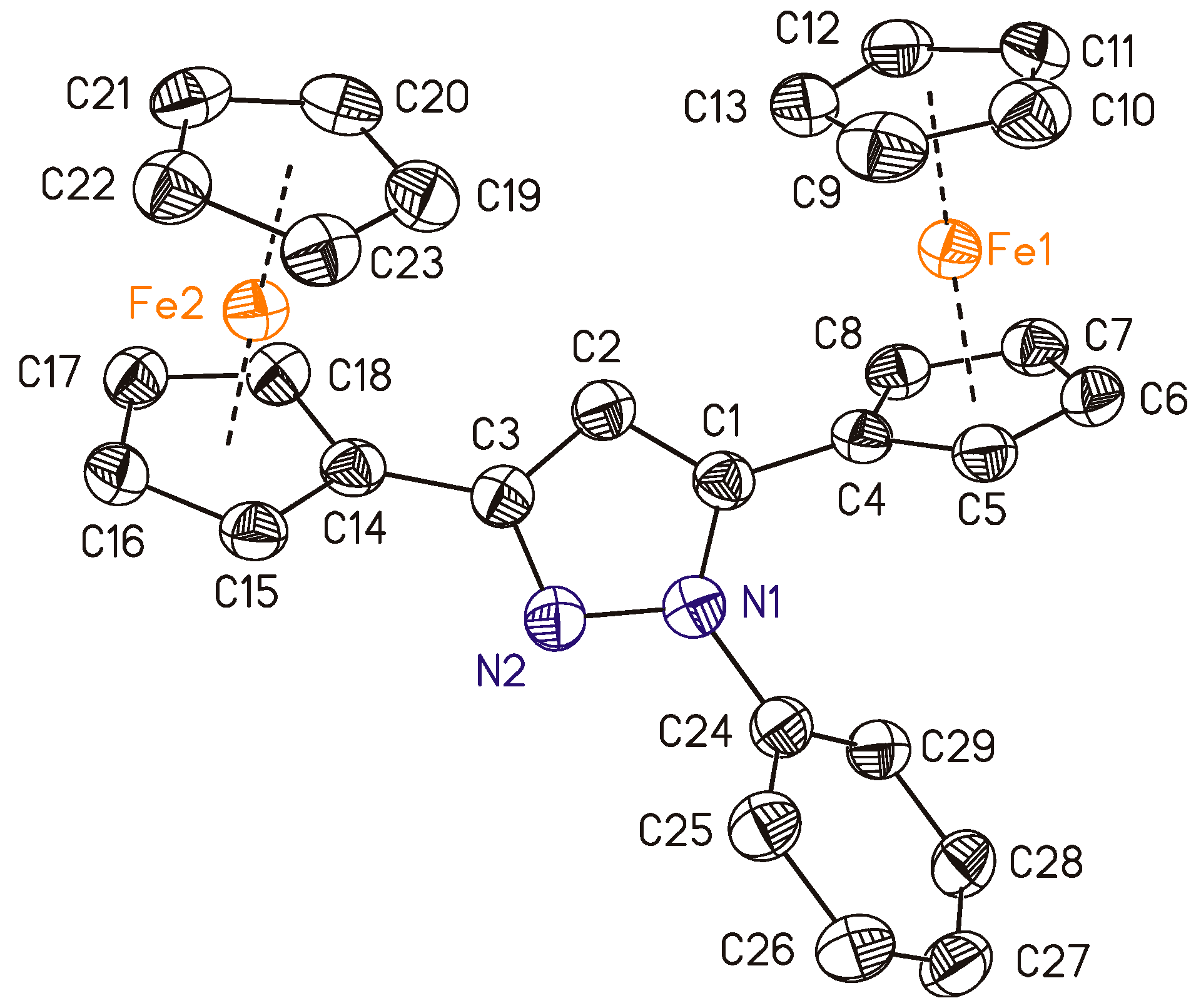
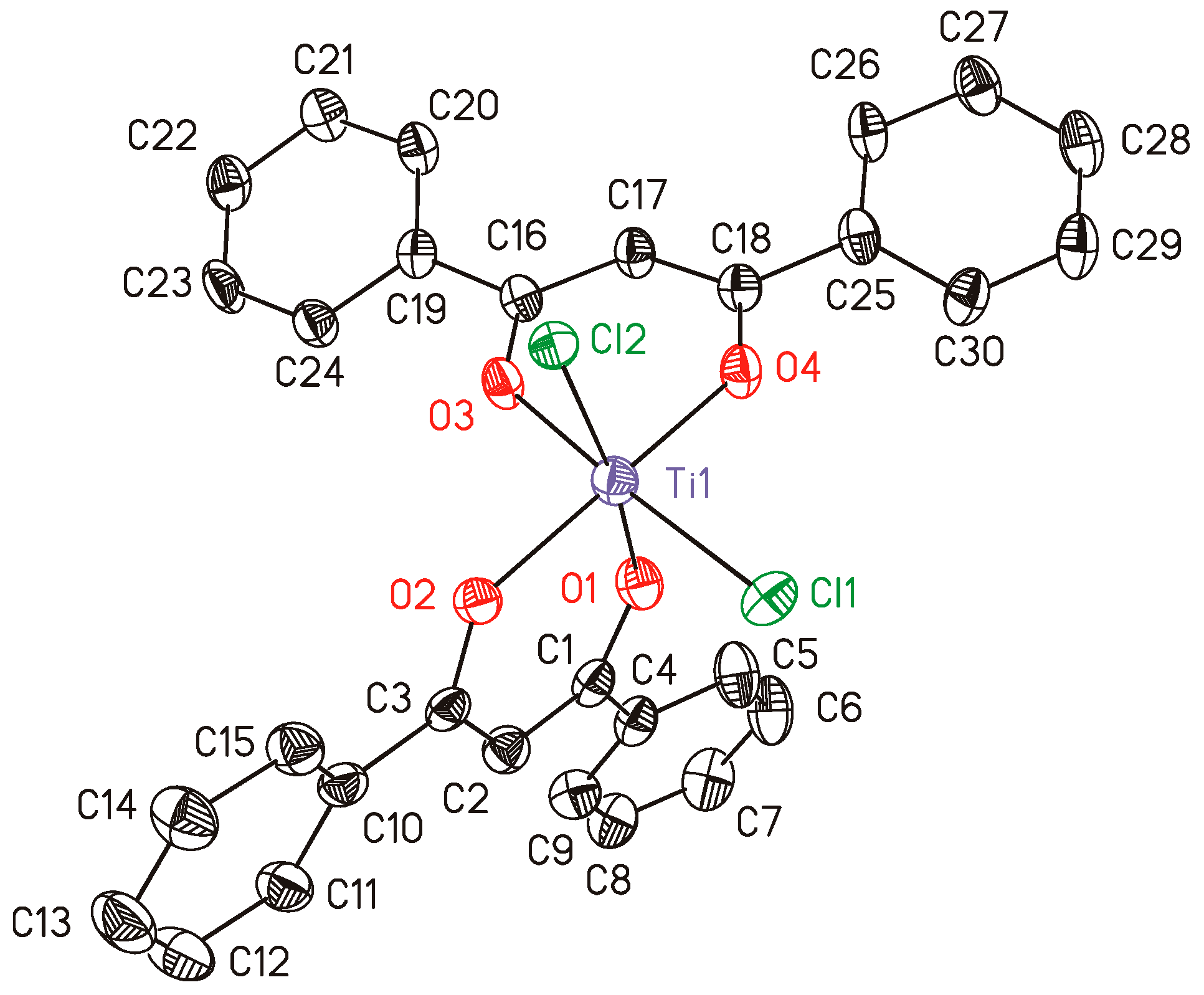

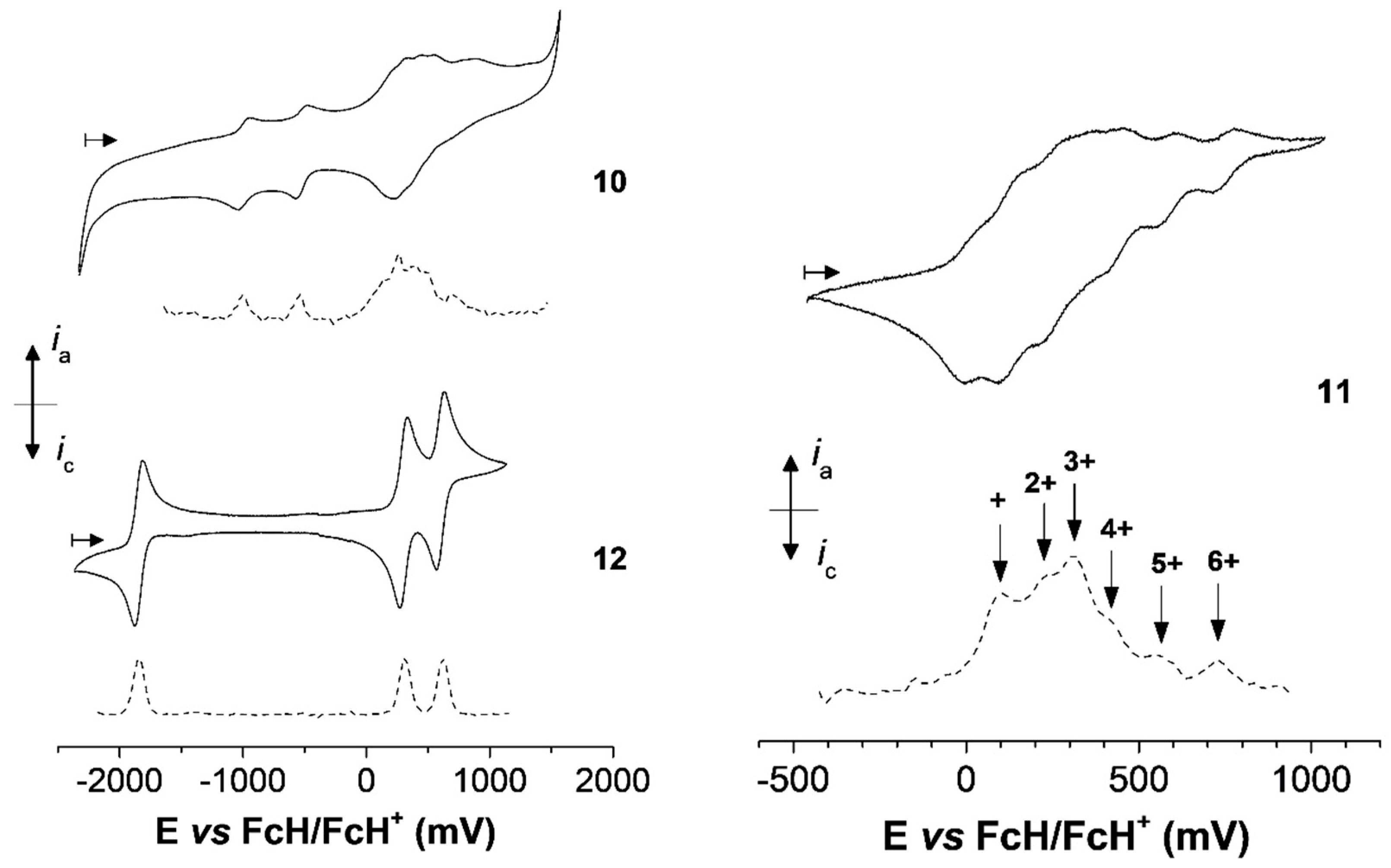
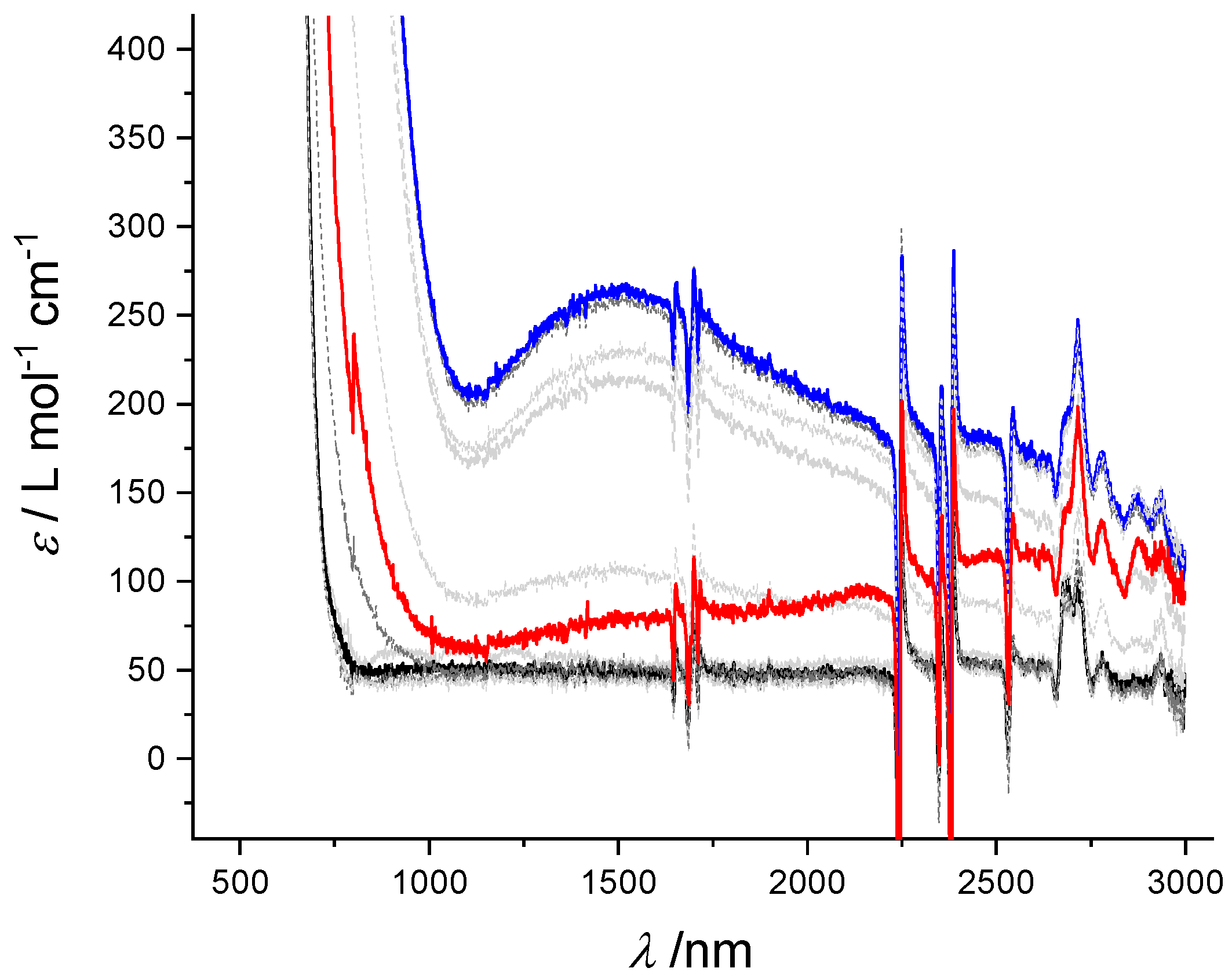
| Hydrogen Bridge-Bonds | ||
| D–H⋯A | D–A/Å | D–H⋯A/° |
| O1–H1O⋯N3 | 2.714(3) | 173(4) |
| O1–H2O⋯N7 | 2.723(4) | 169(4) |
| N2–H2A⋯O1 | 2.801(4) | 165 |
| N5–H5A⋯O1 | 2.732(3) | 167 |
| N4–H4⋯N6 | 3.088(4) | 150 |
| N8–H8A⋯N1 | 3.084(4) | 164 |
| T-shaped π-interactions | ||
| Ct(C5H4)⋯Ct(C5H5) | D/Å | α/° |
| C27–31⋯C14–18 | 4.741(3) | 87.7(2) |
| C50–54⋯C73–77 | 4.651(3) | 85.7(2) |
| Compd. | E1°′ c (ΔEp) d | E2°′ c (ΔEp) d | E3°′ c (ΔEp) d | E4°′ c (ΔEp) d | E5°′ c (ΔEp) d | E6°′ c (ΔEp) d | ΔE°′ e |
|---|---|---|---|---|---|---|---|
| 5 | 110 (60) | 310 (88) | 200 | ||||
| 6 | 110 (60) | 330 (60) | 220 | ||||
| 7 | 240 (60) | 460 (74) | 220 | ||||
| 9 | 235 (60) | 430 (70) | 195 | ||||
| 10b | 140 f | 260 f,g | 385 f | 485 f | 670 f | 120/125/100/185 | |
| 11 | 100 f | 230 f | 305 f | 430 f | 560 f | 730 f | 130/75/125/130/170 |
| Alh | 33 (62) | 123 (62) | 304 (72) | 432 (56) | 583 (62) | 741 (58) | 90/181/128/151/158 |
| 12 | 300 (62) | 600 (64) | 2145/300 | ||||
| 13 | −30 (60) | 210 (64) | 240 | ||||
| 14 | −30 (62) | 210 (64) | 240 | ||||
| 15 | −30 (65) | 205 (66) | 235 |
© 2020 by the authors. Licensee MDPI, Basel, Switzerland. This article is an open access article distributed under the terms and conditions of the Creative Commons Attribution (CC BY) license (http://creativecommons.org/licenses/by/4.0/).
Share and Cite
Lehrich, S.W.; Mahrholdt, J.; Korb, M.; Hildebrandt, A.; Swarts, J.C.; Lang, H. Synthesis, Characterization, and Electrochemistry of Diferrocenyl β-Diketones, -Diketonates, and Pyrazoles. Molecules 2020, 25, 4476. https://doi.org/10.3390/molecules25194476
Lehrich SW, Mahrholdt J, Korb M, Hildebrandt A, Swarts JC, Lang H. Synthesis, Characterization, and Electrochemistry of Diferrocenyl β-Diketones, -Diketonates, and Pyrazoles. Molecules. 2020; 25(19):4476. https://doi.org/10.3390/molecules25194476
Chicago/Turabian StyleLehrich, Steve W., Julia Mahrholdt, Marcus Korb, Alexander Hildebrandt, Jannie C. Swarts, and Heinrich Lang. 2020. "Synthesis, Characterization, and Electrochemistry of Diferrocenyl β-Diketones, -Diketonates, and Pyrazoles" Molecules 25, no. 19: 4476. https://doi.org/10.3390/molecules25194476






